Computational Fluid Dynamics Numerical Simulation on Flow Behavior of Molten Slag–Metal Mixture over a Spinning Cup
Abstract
:1. Introduction
2. CFD Model Development
2.1. Definition of Computational Domain
2.2. Model Assumptions
- The mass flow rate of the molten slag–metal mixture at the inlet remains constant;
- Molten slag and metallic iron are well mixed at the inlet;
- The flow is isothermal, incompressible, and in a steady state;
- In the vicinity of the spinning cup, the airflow is influenced only by the spinning cup and the liquid motion;
- In order to limit the computation amount without losing accuracy, the computation domain is confined to covering appropriate portions of the pouring liquid stream and the air above the spinning cup;
- The center axis of the spinning cup precisely coincides with that of the cylindrical pouring stream of the molten slag–metal mixture.
2.3. Computation Grids, Boundary Conditions, and Material Properties
2.4. Governing Equations
- Continuity Equation:
- 2.
- Momentum Equation:
- 3.
- SST turbulence equations:
- 4.
- Volume fraction equation:
2.5. Solution Method and Computation Scheme
3. Results and Discussion
3.1. High-Temperature Experiments on Centrifugal Granulation of Molten Slag–Metal Mixtures
3.1.1. Experimental Condition
3.1.2. Experimental Results
3.2. Spreading Flow Behavior of Molten Slag–Metal Mixture Inside a Spinning Cup
3.2.1. Behavior of Molten Slag Flow on Spinning Cup Inner Face
3.2.2. Behavior of Liquid Metal Flow on Spinning Cup Inner Face
3.3. Effect of Design and Operating Parameters on Liquid Film Thickness at the Edge of Spinning Cup
3.3.1. Effect of Spinning Cup Size on Liquid Film Thickness
3.3.2. Effect of Cup Spinning Speed on Liquid Film Thickness
3.3.3. Effect of Liquid Feeding Rate on Liquid Film Thickness
3.3.4. Effect of Metal Content in Slag on Liquid Film Thickness and Slag Particle Size
3.4. Model Validation
4. Conclusions
- The molten slag–metal mixture exhibits an immiscible state between the slag and the liquid metal on the inner face of the spinning cup, forming layering or wrapping patterns. Due to the action of interfacial tension, the metallic iron is unevenly dispersed inside the liquid slag film layer.
- The results of the high-temperature centrifugal granulation experiments indicate that an increase in cup spinning speed increases the proportion of smaller-sized slag particles. For a constant liquid feeding rate and cup spinning speed, an increase in metallic iron content in slag increases the Sauter mean diameter of the slag particles. For the cup spinning speed of 2500 RPM, when the metallic iron content in slag increases from 5% to 15%, the Sauter mean diameter of the slag particles decreases by 13.77%.
- The liquid film thickness at the spinning cup edge increases with the increase in liquid feeding rate but decreases with the increase in cup spinning speed. For the spinning cup with a diameter of 30 mm, the liquid film thickness decreases by 10.88% when the cup spinning speed is increased from 2000 RPM to 3000 RPM. For every 1 kg·min−1 increase in the liquid feeding rate, the liquid film thickness increases by about 28.15%. When the spinning cup diameter is increased from 30 mm to 50 mm, the liquid film thickness can be reduced by 19.26%.
- The diameter of slag particles correlates positively with the increase in the liquid film thickness at the spinning cup edge. The ratio between the arithmetic mean diameter of slag particles and the liquid film thickness decreases nearly linearly with the increase in the metallic iron content in slag, and, on average, the mean diameter of the slag particles is approximately 4.25 times the liquid film thickness at the spinning cup edge. Therefore, this ratio can be utilized for estimating the slag particle size based on the liquid film thickness at the spinning cup edge predicted using the two-dimensional CFD model developed in this work.
Author Contributions
Funding
Data Availability Statement
Conflicts of Interest
References
- Guo, J.; Bao, Y.; Wang, M. Steel slag in China: Treatment, recycling, and management. Waste Manag. 2018, 78, 318–330. [Google Scholar] [CrossRef] [PubMed]
- Gao, W.; Zhou, W.; Lyu, X.; Liu, X.; Su, H.; Li, M.; Wang, H. Comprehensive utilization of steel slag: A review. Powder Technol. 2023, 422, 118449. [Google Scholar] [CrossRef]
- Wu, J.; Tan, Y.; Li, P.; Wang, H.; Zhu, X.; Liao, Q. Centrifugal-Granulation-Assisted thermal energy recovery towards low-carbon blast furnace slag treatment: State of the art and future challenges. Appl. Energy 2022, 325, 119835. [Google Scholar] [CrossRef]
- Rauscher, J.; Kelly, R.; Cole, J. An Asymptotic Solution for the Laminar Flow of a Thin Film on a Rotating Disk. J. Appl. Mech. 1973, 40, 43–47. [Google Scholar] [CrossRef]
- Liu, J.; Yu, Q.; Guo, Q. Experimental investigation of liquid disintegration by rotary cups. Chem. Eng. Sci. 2012, 73, 44–50. [Google Scholar] [CrossRef]
- Liu, J.; Yu, Q.; Li, P.; Du, W. Cold experiments on ligament formation for blast furnace slag granulation. Appl. Therm. Eng. 2012, 40, 351–357. [Google Scholar] [CrossRef]
- Mizuochi, T.; Akiyama, T.; Shimada, T.; Kasai, E. Feasibility of Rotary Cup Atomizer for Slag Granulation. Trans. Iron Steel Inst. Jpn. 2001, 41, 1423–1428. [Google Scholar] [CrossRef]
- Sisoev, G.; Matar, O.; Lawrence, C. Axisymmetric wave regimes in viscous liquid film flow over a spinning disk. J. Fluid Mech. 2003, 495, 385–411. [Google Scholar] [CrossRef]
- Tan, Y.; Wang, H.; Zhu, X.; Lv, Y.; Ding, Y.; Liao, Q. Film fragmentation mode: The most suitable way for centrifugal granulation of large flow rate molten blast slag towards high-efficiency waste heat recovery for industrialization. Appl. Energy 2020, 276, 115454. [Google Scholar] [CrossRef]
- Burns, J.; Ramshaw, C.; Jachuck, R. Measurement of liquid film thickness and the determination of spin-up radius on a rotating disc using an electrical resistance technique. Chem. Eng. Sci. 2003, 58, 2245–2253. [Google Scholar] [CrossRef]
- Ghiasy, D.; Boodhoo, K.; Tham, M. Thermographic analysis of thin liquid films on a rotating disc: Approach and challenges. Appl. Therm. Eng. 2012, 44, 39–49. [Google Scholar] [CrossRef]
- Lv, Y.; Zhu, X.; Wang, H.; Dai, M.; Ding, Y.; Wu, J.; Liao, Q. A hybrid cooling system to enable adhesion-free heat recovery from centrifugal granulated slag particles. Appl. Energy 2021, 303, 117645. [Google Scholar] [CrossRef]
- Purwanto, H.; Mizuochi, T.; Akiyama, T. Prediction of Granulated Slag Properties Produced from Spinning Disk Atomizer by Mathematical Model. Mater. Trans. 2005, 46, 1324–1330. [Google Scholar] [CrossRef]
- Purwanto, H.; Mizuochi, T.; Tobo, H.; Takagi, M.; Akiyamaet, T. Characteristics of Glass Beads from Molten Slag Produced by Rotary Cup Atomizer. Mater. Trans. 2004, 45, 3286–3290. [Google Scholar] [CrossRef]
- Pan, Y.; Witt, P.; Xie, D. CFD simulation of free surface flow and heat transfer of liquid slag on a spinning disc for a novel dry slag granulation process. Prog. Comput. Fluid Dyn. 2010, 10, 292–299. [Google Scholar] [CrossRef]
- Chang, Q.; Li, X.; Ni, H.; Zhu, W.; Pan, C.; Hu, S. Modeling on Dry Centrifugal Granulation Process of Molten Blast Furnace Slag. ISIJ Int. 2015, 55, 1361–1366. [Google Scholar] [CrossRef]
- Li, M.; Zhao, J.; Zhang, X.; Xun, N.; Meng, H.; Wu, Z.; Wang, S. Effects of Granulator Structure and Cooperating Mode with Slag Tube on the Centrifugal Granulation Characteristics of Molten Slag. Appl. Therm. Eng. 2021, 193, 117026. [Google Scholar] [CrossRef]
- Wang, D.; Ling, X.; Peng, H. Theoretical analysis of free-surface film flow on the rotary granulating disk in waste heat recovery process of molten slag. Appl. Therm. Eng. 2013, 63, 387–395. [Google Scholar] [CrossRef]
- Pan, Y.; Witt, P.; Kuan, B.; Xie, D. CFD Modelling of the Effects of Operating Parameters on the Spreading of Liquids on a Spinning Disc. J. Comput. Multiph. Flows 2014, 6, 49–64. [Google Scholar] [CrossRef]
- Pan, Y.; Zhao, M.; Ma, P.; Li, J.; Huo, Z.; Li, H. CFD Modeling of Melt Spreading Behavior on Spinning Discs and Cups for Centrifugal Granulation of Molten Slag. J. Sustain. Metall. 2019, 5, 195–203. [Google Scholar] [CrossRef]
- Liu, J.; Yu, Q.; Dou, C. Experimental study on rotating cup granulation of blast furnace slag. J. Northeast. Univ. (Nat. Sci.) 2009, 30, 1163–1165. (In Chinese) [Google Scholar]
- Zhang, S.; Zhao, M.; Ma, P.; Pan, Y.; Meng, F. Numerical modeling of centrifugal granulation of molten blast furnace slag using spinning cups. Iron Steel 2020, 55, 127–133. [Google Scholar]
- Gao, J.; Feng, Y.; Zhang, W.; Feng, D.; Zhang, X. Prediction on particle size characteristics of high-temperature liquid blast furnace slag in a centrifugal granulation process. Powder Technol. 2020, 376, 527–536. [Google Scholar] [CrossRef]
- Gao, J.; Feng, Y.; Feng, D.; Zhang, X. Granulation performance by hybrid centrifugal air blast technique for treatment of liquid slag. Powder Technol. 2021, 392, 204–211. [Google Scholar] [CrossRef]
- Tan, Y.; Ding, B.; Shi, J.; Yan, H.; Wu, Y.; Wu, J. Modelling the film fragmentation of industrial-scale centrifugal granulation of high-temperature molten slag. Powder Technol. 2023, 426, 118654. [Google Scholar] [CrossRef]
- Peng, L.; Li, L.; Zhao, W. Numerical study of inlet eccentricity on liquid film spreading and splitting in centrifugal granulation assisted thermal energy recovery. Powder Technol. 2022, 414, 118079. [Google Scholar] [CrossRef]
- Liu, Z.; Tu, Q.; Ma, W.; Liu, J.; Tao, S. Experimental investigation on centrifugal granulation of molten yellow phosphorus slag. Chem. Eng. Res. Des. 2023, 197, 548–557. [Google Scholar] [CrossRef]
- Xu, N.; Zhao, J.; Zhang, X.; Li, M.; Ma, C.; Wu, Z.; Meng, H.; Wang, S. Flow Characteristics of the Liquid Film During Centrifugal Granulation of Liquid Slag on the Surface of Rotary Cup. J. Sustain. Metall. 2022, 8, 632–645. [Google Scholar] [CrossRef]
- ANSYS Inc. ANSYS CFX User’s Manual, Release 15.0; ANSYS Inc.: Canonsburg, PA, USA, 2013. [Google Scholar]
- Inaba, S.; Kimura, Y.; Shibata, H.; Ohta, H. Measurement of physical properties of slag formed around the raceway in the working blast furnace. ISIJ Int. 2004, 44, 2120–2126. [Google Scholar] [CrossRef]
- Chen, J. Steelmaking Commonly Used Charts Data Book, 1st ed.; Metallurgical Industry Press: Beijing, China, 1984; p. 231. [Google Scholar]
- Ramirez-Argaez, M.; Conejo, A.; Guzman, Y.; Trapaga, G. Influence of the top slag layer on the flow dynamics in AC electric arc furnaces. Int. J. Eng. Syst. Model. Simul. 2010, 2, 217–225. [Google Scholar]
- Hirt, C.; Nichols, B. Volume of fluid (VOF) method for the dynamics of free boundaries. J. Comput. Phys. 1981, 39, 201–225. [Google Scholar] [CrossRef]
- Menter, F. Two-equation eddy-viscosity turbulence models for engineering applications. AIAA J. 1994, 32, 1598–1605. [Google Scholar] [CrossRef]
- Brackbill, J.; Kothe, D.; Zemach, C. A continuum method for modeling surface tension. J. Comput. Phys. 1992, 100, 335–354. [Google Scholar] [CrossRef]

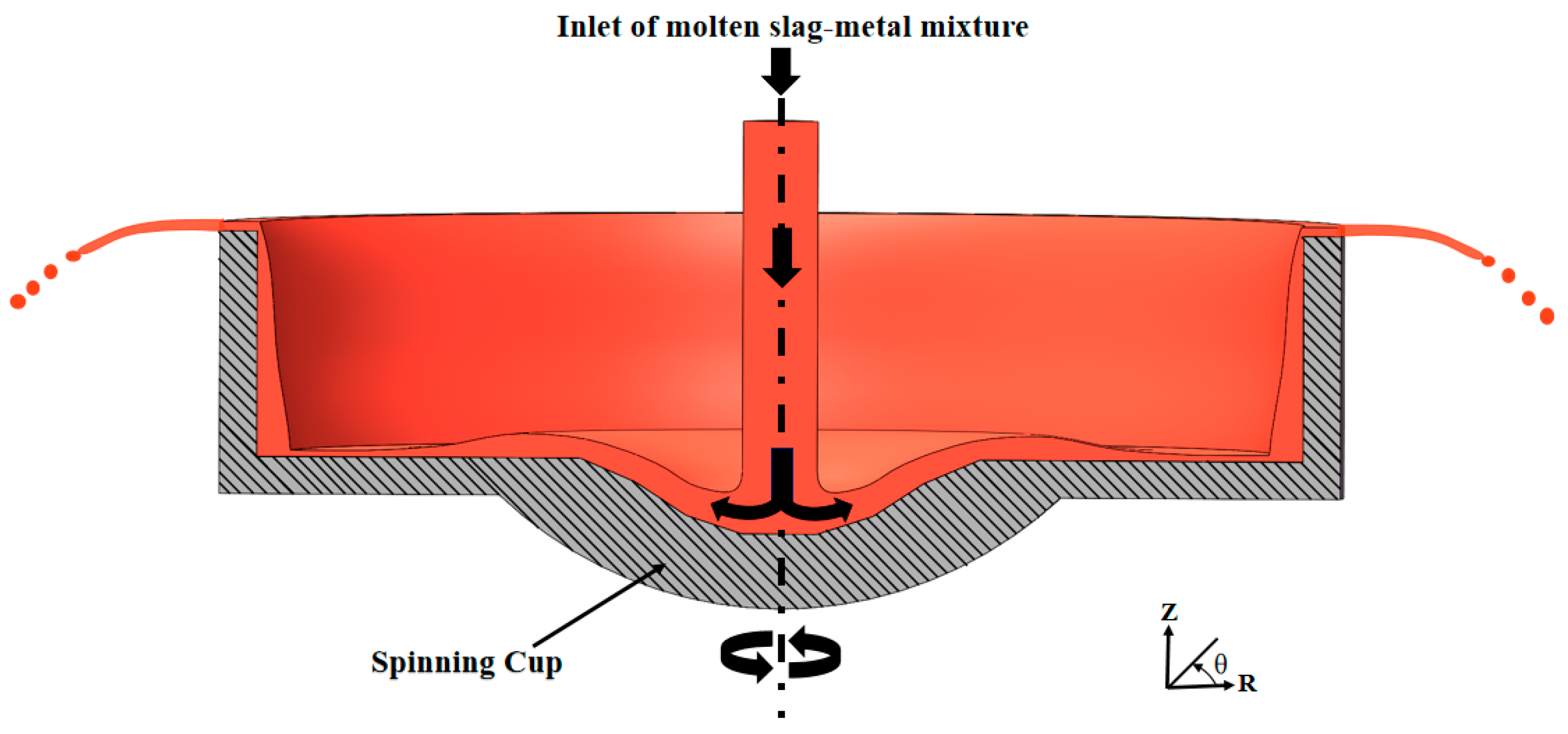
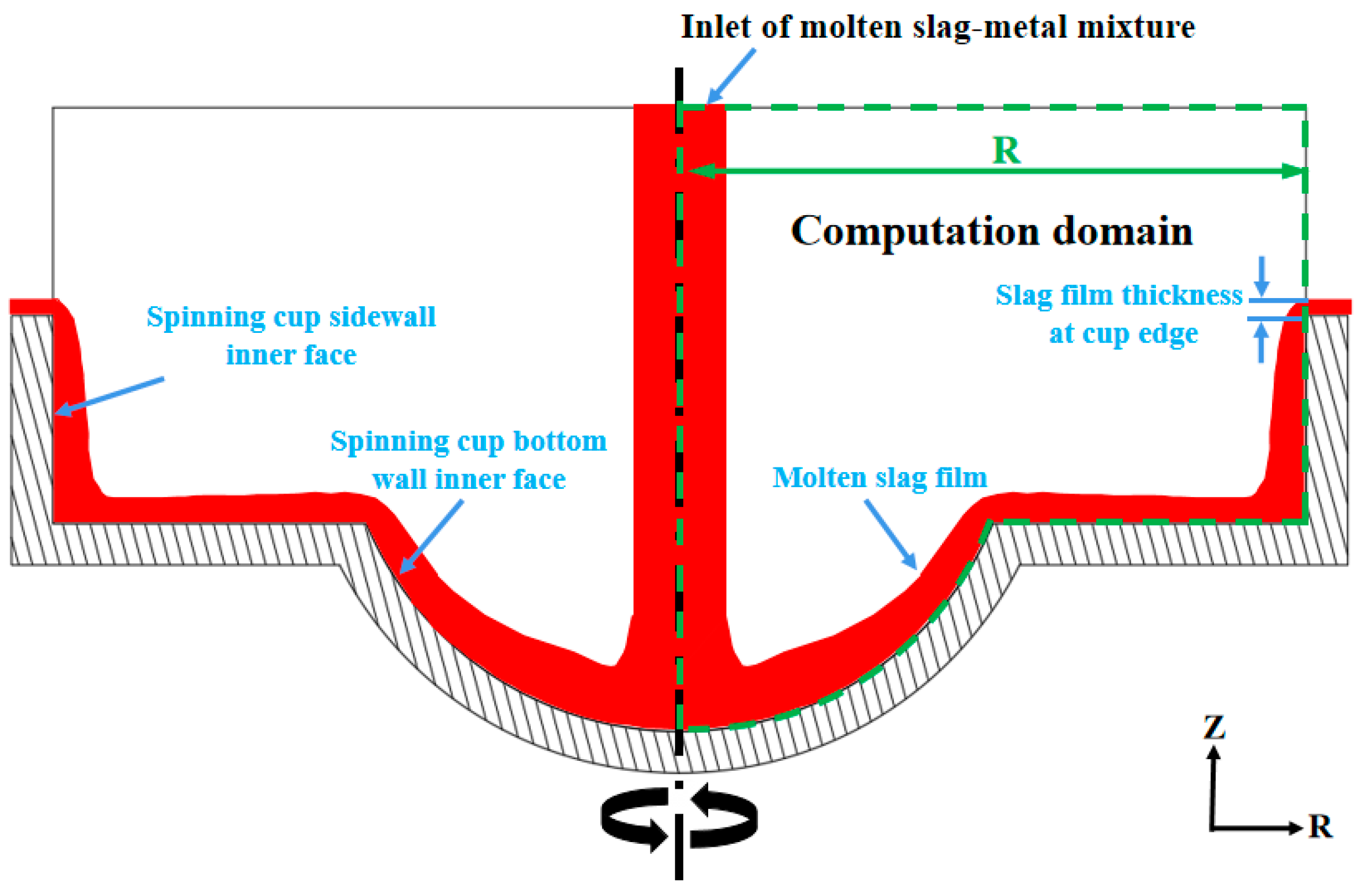
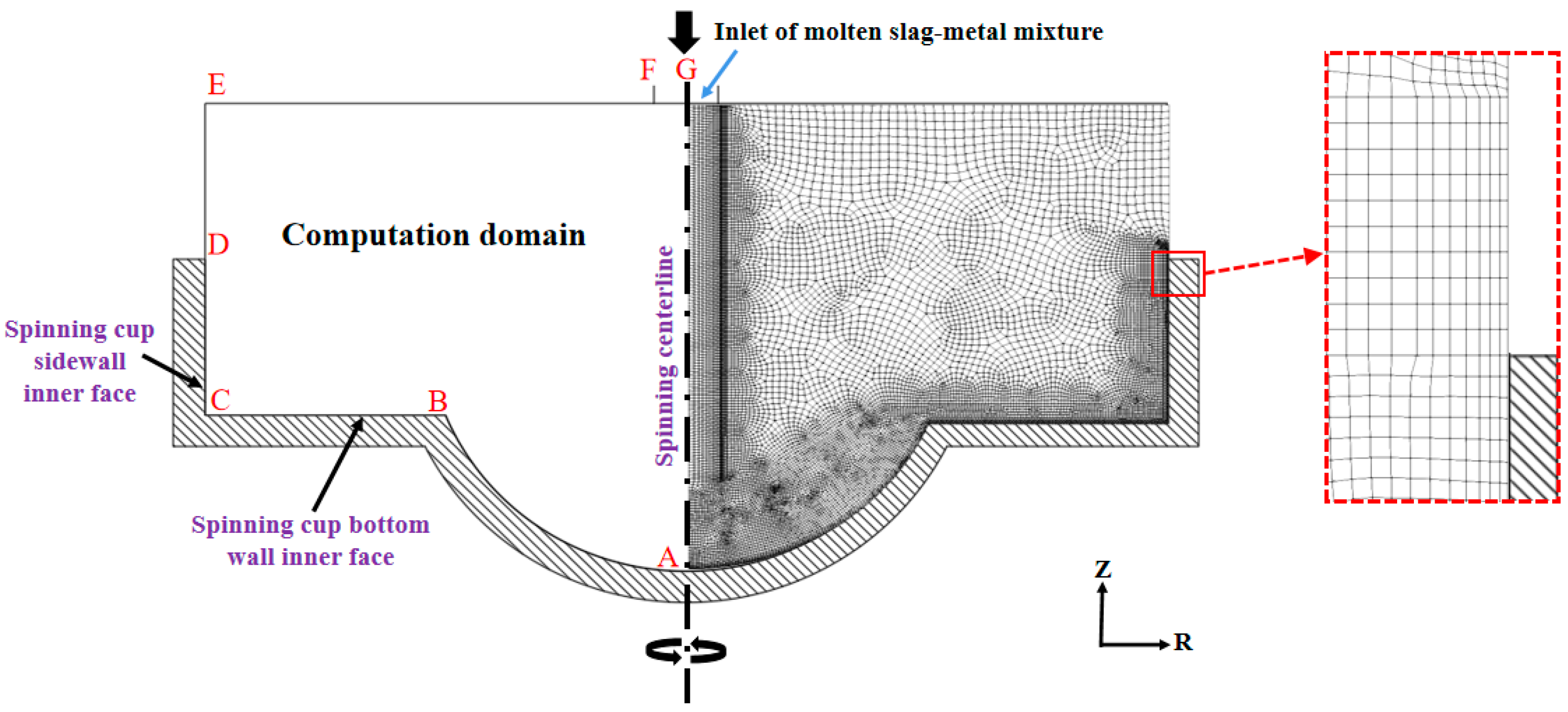


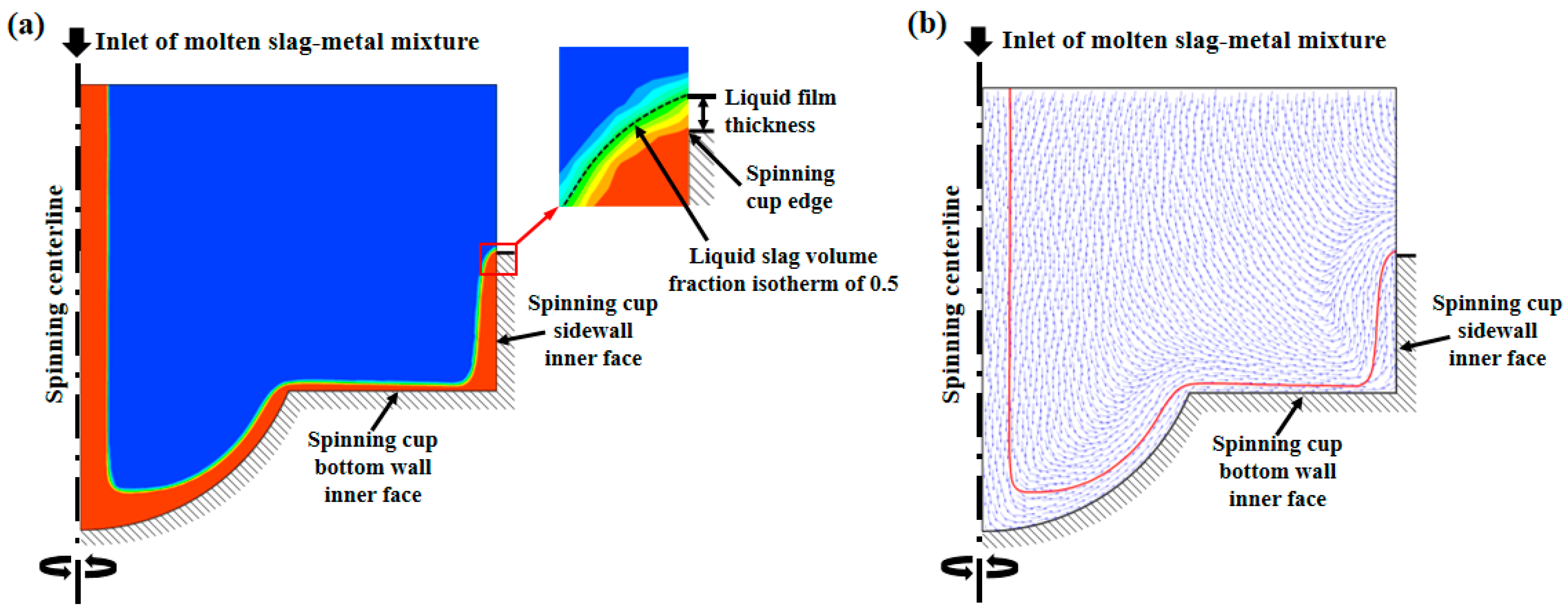
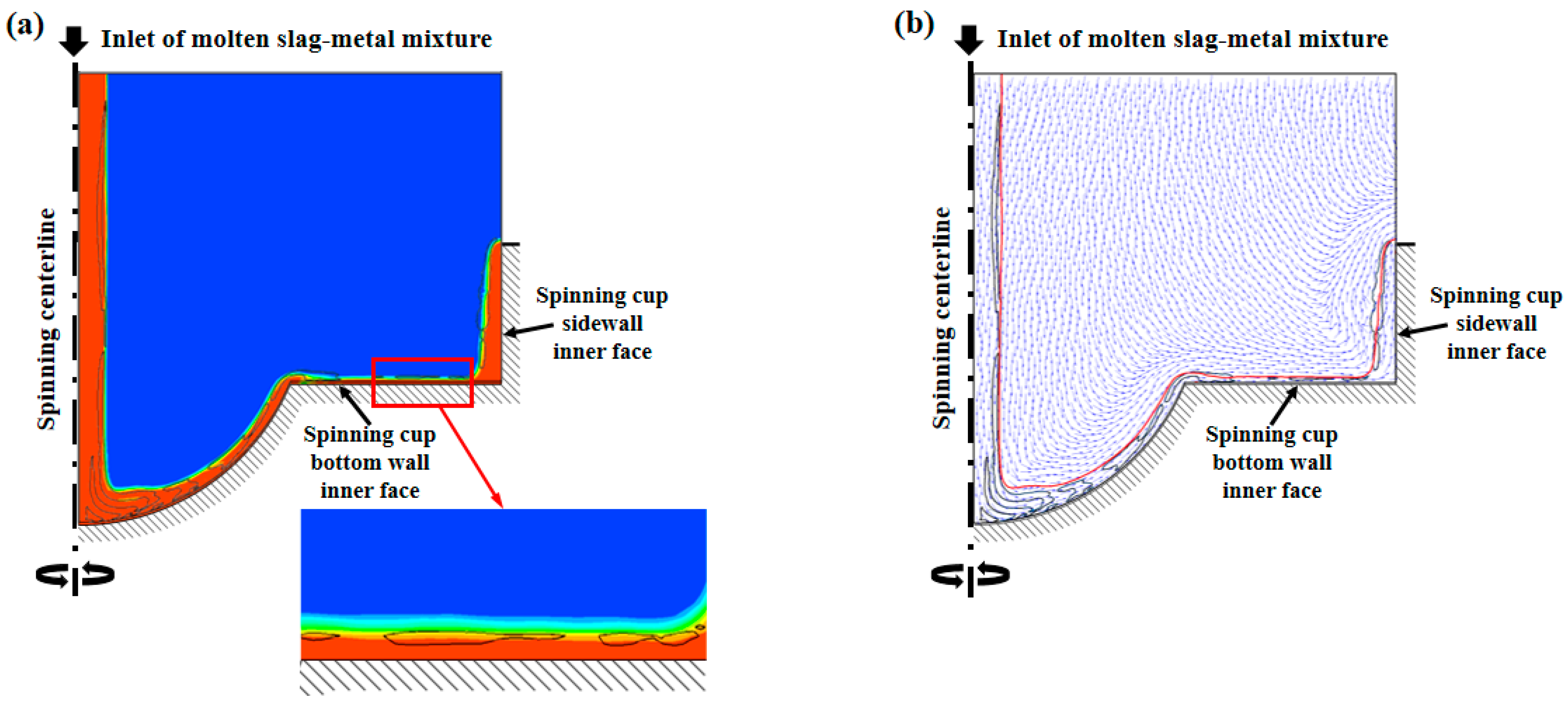
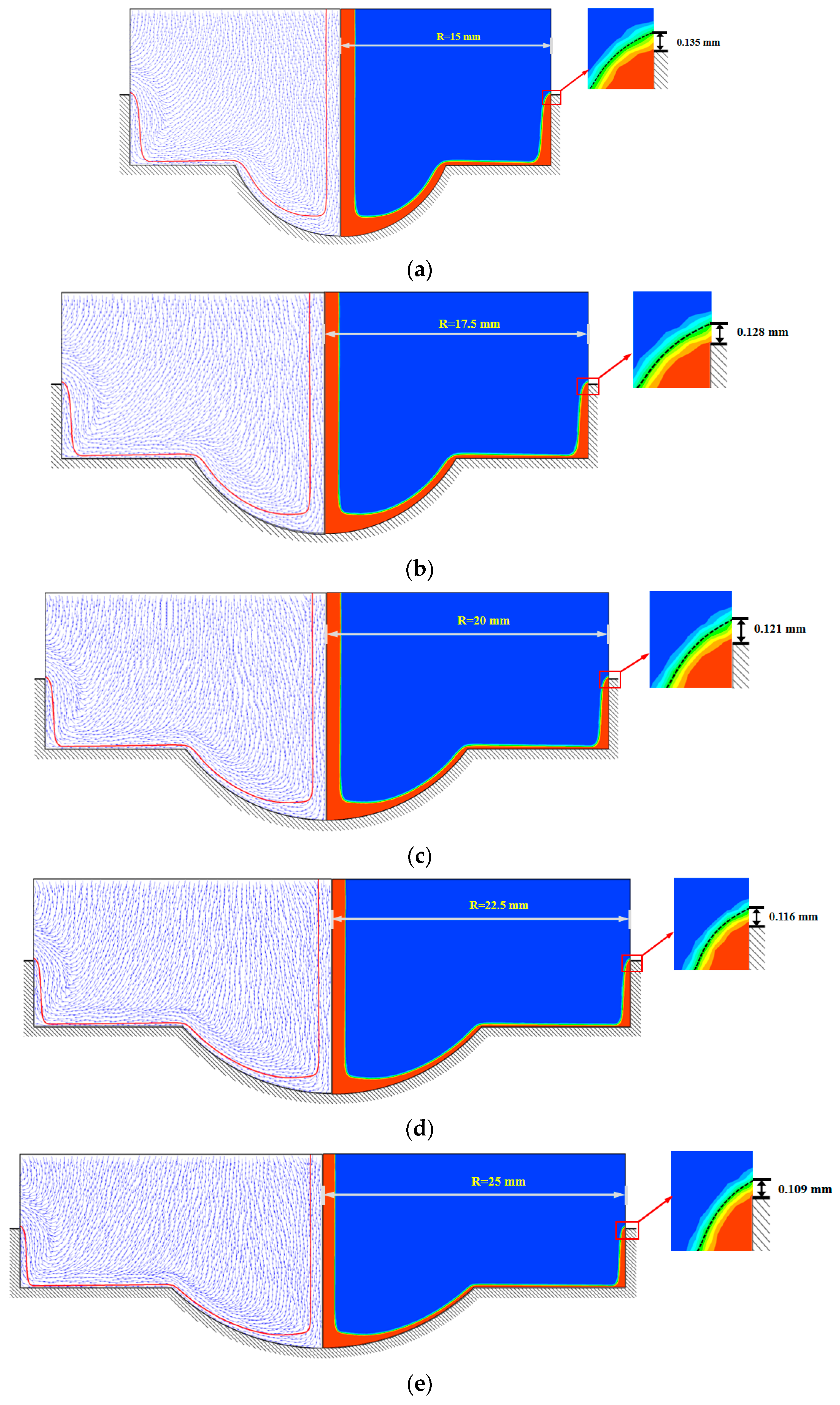
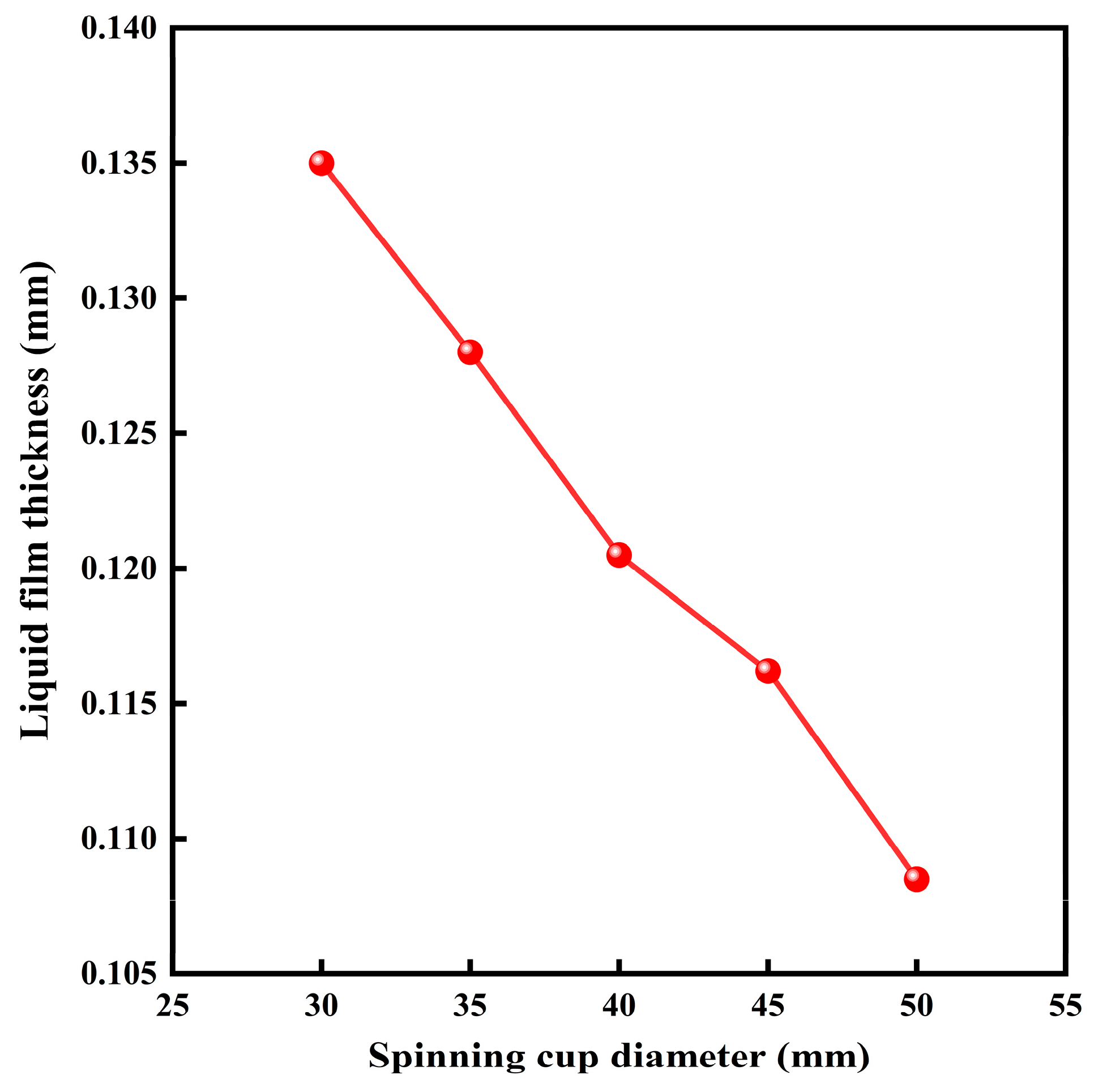
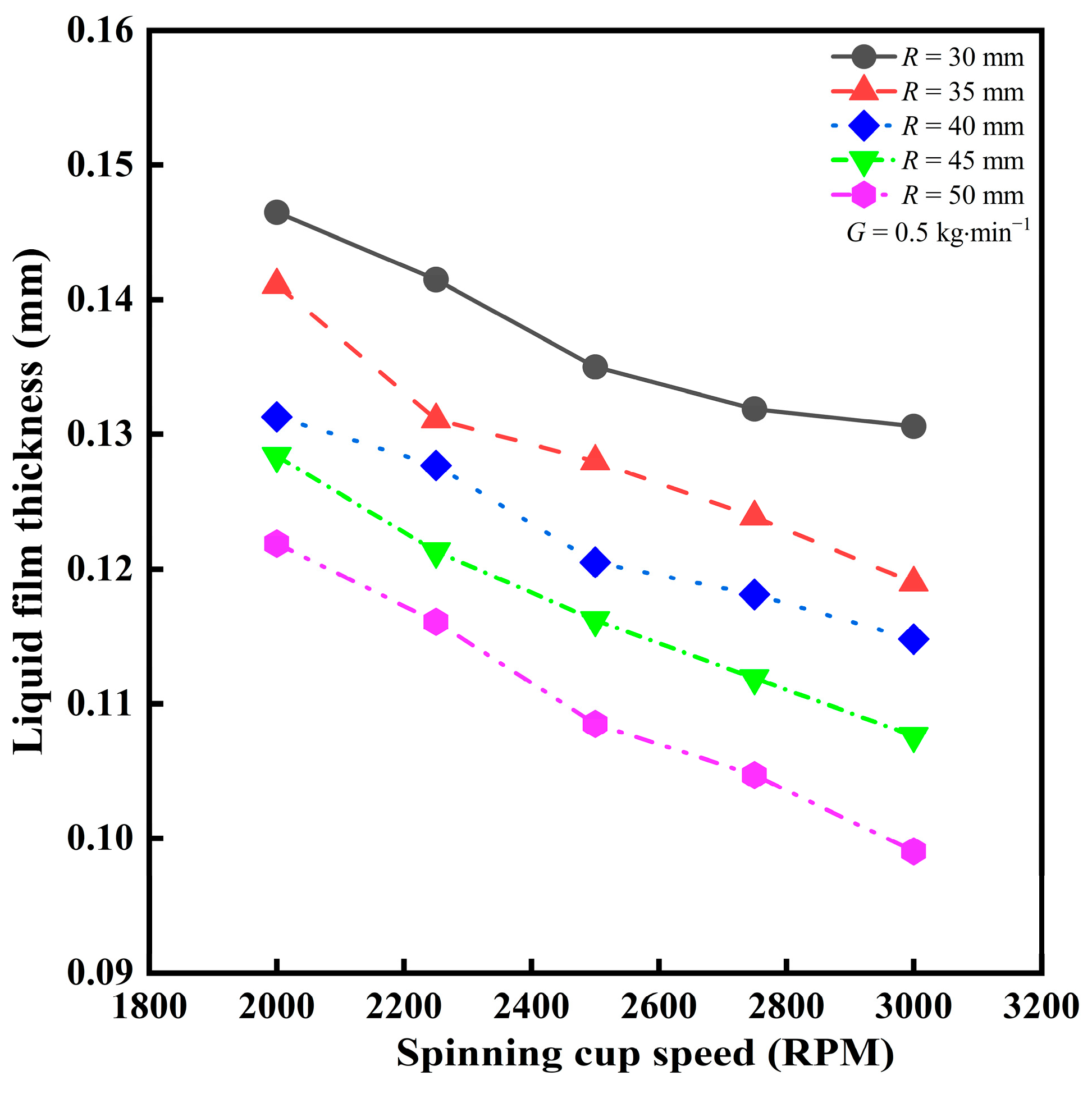
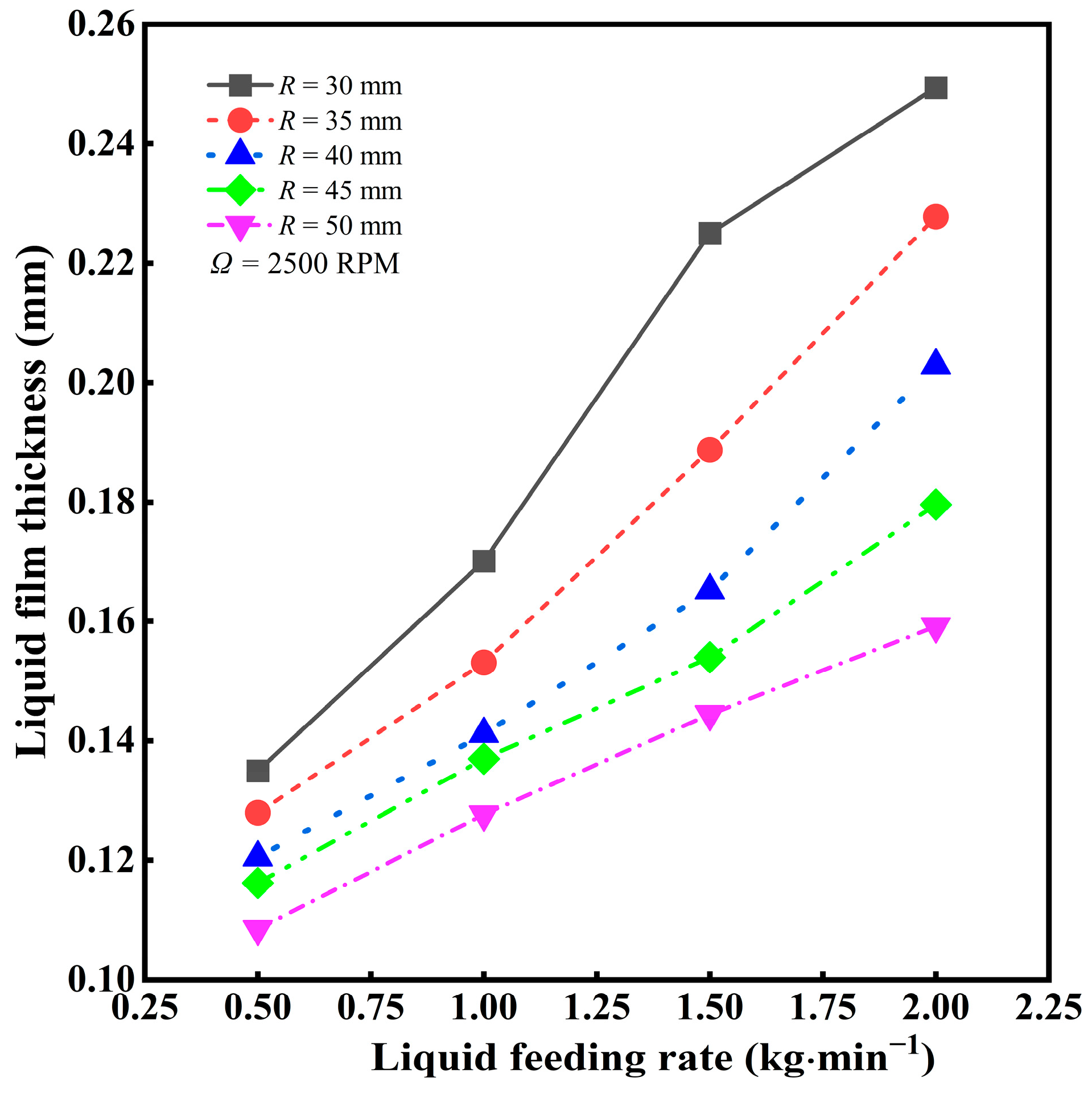
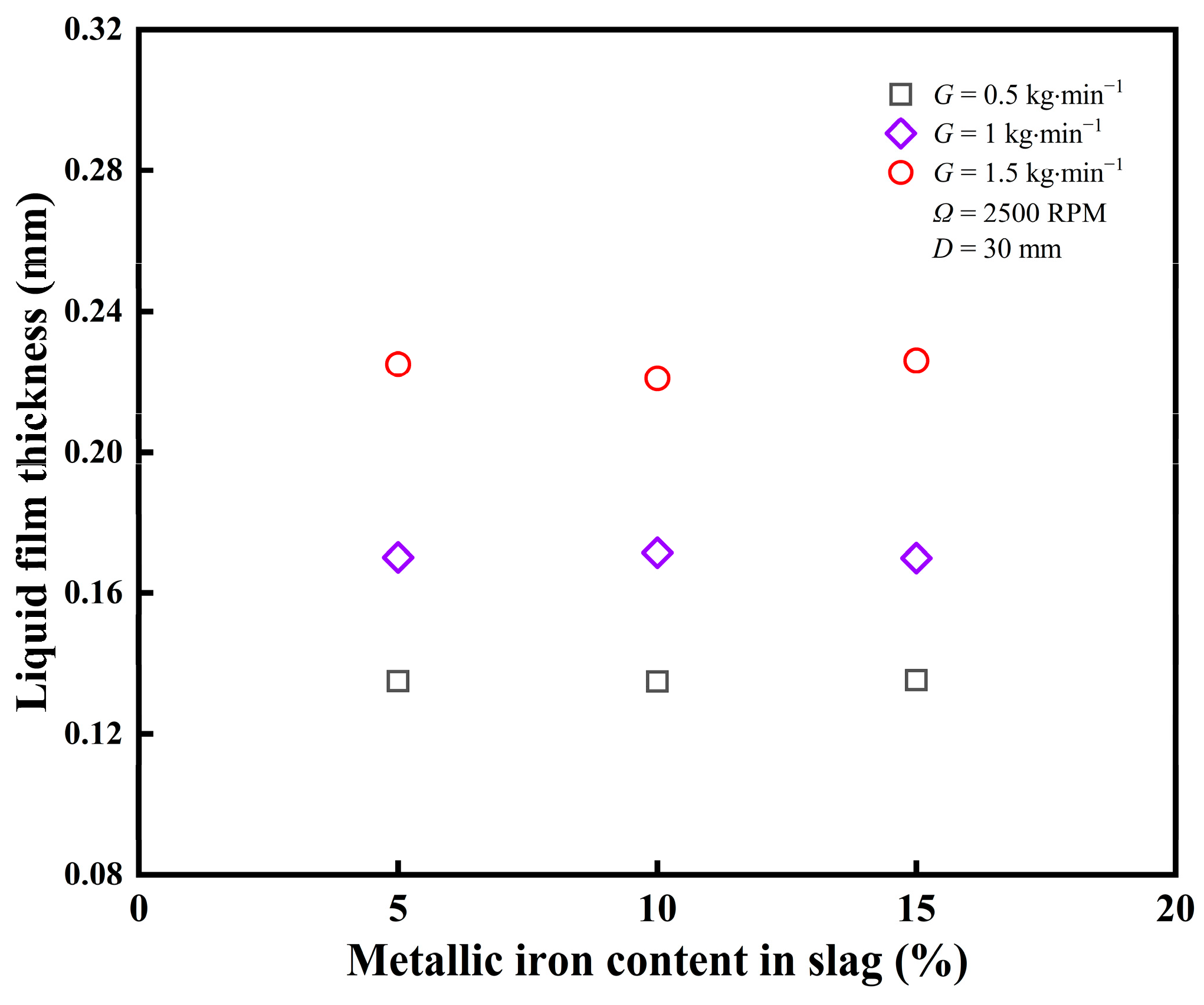
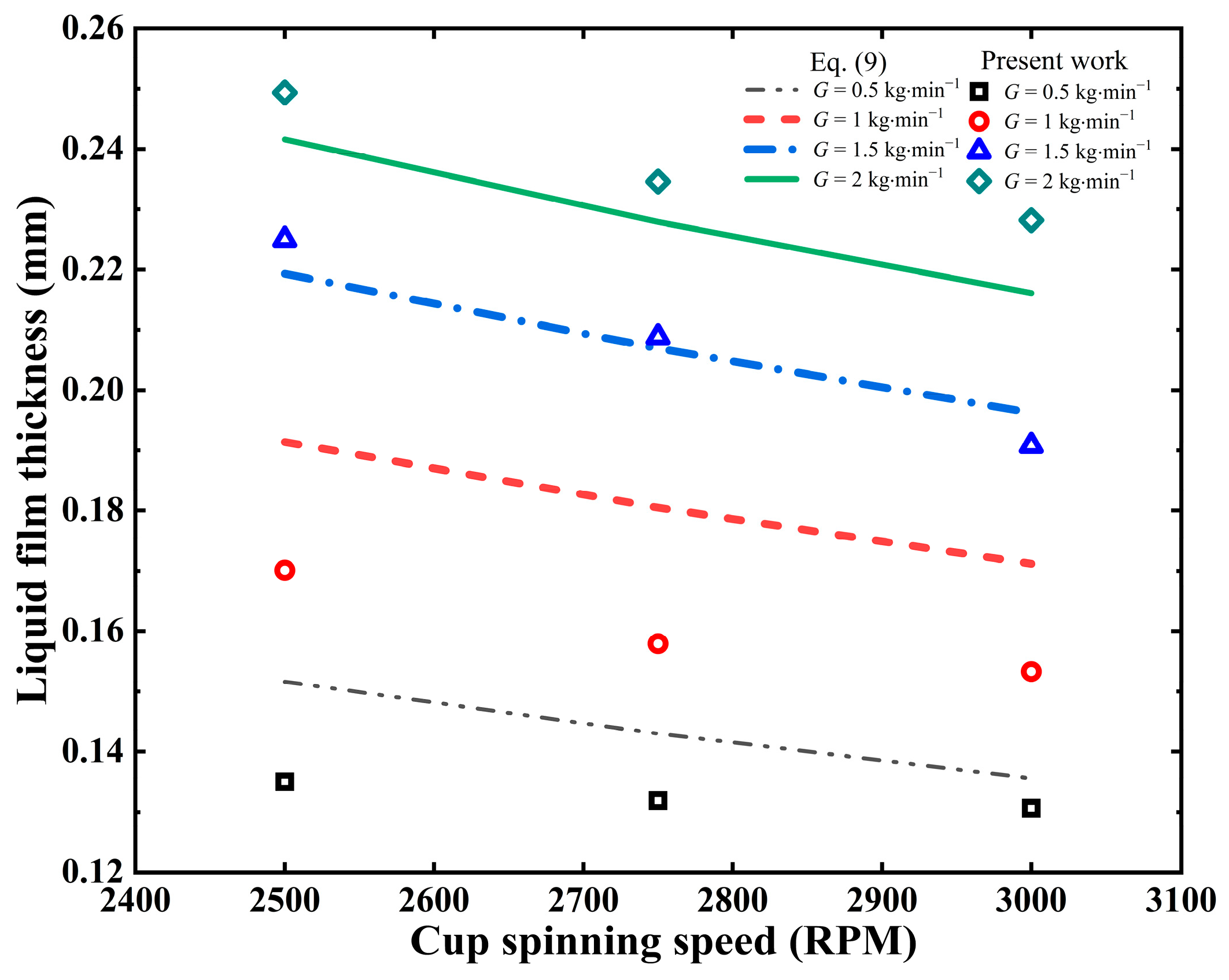
| Boundary | Boundary Name | Boundary Type | Condition |
|---|---|---|---|
| ABC | Spinning cup bottom wall inner face | Wall | Non-slip spinning wall |
| CD | Spinning cup sidewall inner face | Wall | Non-slip spinning wall |
| DE | Side boundary | Opening | Fixed pressure (=0 Pa) |
| EF | Top boundary | Opening | Fixed pressure (=0 Pa) |
| FG | Liquid inlet | Inlet | Fixed mass flowrate |
| AG | Center axis | Rotational symmetrical axis | Zero flux |
| Material | Density (kg·m−3) | Viscosity (Pa·s) |
|---|---|---|
| Liquid blast furnace slag | 2590 | 0.5 |
| Air | 1.185 | 1.831 × 10−5 |
| Steel | 7200 | 0.0065 |
| Simulation Case Number | Liquid Feeding Rate (kg·min−1) | Cup Spinning Speed (RPM) | Spinning Cup Diameter (mm) | Metallic Iron Content in Slag (%) |
|---|---|---|---|---|
| 1 | 0.5 | 2000 | 30 | 10 |
| 2 | 0.5 | 2250 | 30 | 10 |
| 3 | 0.5 | 2500 | 30 | 10 |
| 4 | 0.5 | 2750 | 30 | 10 |
| 5 | 0.5 | 3000 | 30 | 10 |
| 6 | 1 | 2500 | 30 | 10 |
| 7 | 1 | 2750 | 30 | 10 |
| 8 | 1 | 3000 | 30 | 10 |
| 9 | 1.5 | 2500 | 30 | 10 |
| 10 | 1.5 | 2750 | 30 | 10 |
| 11 | 1.5 | 3000 | 30 | 10 |
| 12 | 2 | 2500 | 30 | 10 |
| 13 | 2 | 2750 | 30 | 10 |
| 14 | 2 | 3000 | 30 | 10 |
| 15 | 0.5 | 2500 | 35 | 10 |
| 16 | 0.5 | 2500 | 40 | 10 |
| 17 | 0.5 | 2500 | 45 | 10 |
| 18 | 0.5 | 2500 | 50 | 10 |
| 19 | 0.5 | 2500 | 30 | 5 |
| 20 | 1 | 2500 | 30 | 5 |
| 21 | 1.5 | 2500 | 30 | 5 |
| 22 | 0.5 | 2500 | 30 | 15 |
| 23 | 1 | 2500 | 30 | 15 |
| 24 | 1.5 | 2500 | 30 | 15 |
| Metallic Iron Content in Slag (%) | Slag Particle Diameter to Liquid Film Thickness Ratio |
|---|---|
| 5 | 4.57 |
| 10 | 4.24 |
| 15 | 3.94 |
| Average | 4.25 |
Disclaimer/Publisher’s Note: The statements, opinions and data contained in all publications are solely those of the individual author(s) and contributor(s) and not of MDPI and/or the editor(s). MDPI and/or the editor(s) disclaim responsibility for any injury to people or property resulting from any ideas, methods, instructions or products referred to in the content. |
© 2024 by the authors. Licensee MDPI, Basel, Switzerland. This article is an open access article distributed under the terms and conditions of the Creative Commons Attribution (CC BY) license (https://creativecommons.org/licenses/by/4.0/).
Share and Cite
Wang, J.; Pan, Y.; Zhao, M.; Ma, P.; Lv, S.; Huang, Y. Computational Fluid Dynamics Numerical Simulation on Flow Behavior of Molten Slag–Metal Mixture over a Spinning Cup. Processes 2024, 12, 372. https://doi.org/10.3390/pr12020372
Wang J, Pan Y, Zhao M, Ma P, Lv S, Huang Y. Computational Fluid Dynamics Numerical Simulation on Flow Behavior of Molten Slag–Metal Mixture over a Spinning Cup. Processes. 2024; 12(2):372. https://doi.org/10.3390/pr12020372
Chicago/Turabian StyleWang, Jun, Yuhua Pan, Ming Zhao, Ping Ma, Shali Lv, and Yawei Huang. 2024. "Computational Fluid Dynamics Numerical Simulation on Flow Behavior of Molten Slag–Metal Mixture over a Spinning Cup" Processes 12, no. 2: 372. https://doi.org/10.3390/pr12020372




